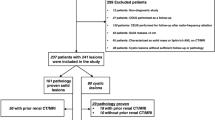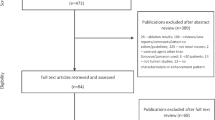Abstract
Objectives
To develop and prospectively validate a novel weighted quantitative scoring system based on CT findings, namely, the renal cyst index (RCI), aimed at preoperatively predicting the pathological features of cystic renal masses (CRMs).
Methods
The RCI was based on four critical features of CRMs: the cyst wall, septal, nodule, and cyst contents. These parameters were scored with 1, 2, or 3 points. Weight coefficients for these parameters were determined by the multivariable logistic regression. The odds ratio (OR) and 95% confidence interval (95% CI) were used to summarise the results. The RCI was defined as the sum of these four weight coefficients. Malignancy risk prediction models were built based on the retrospective evaluation of 441 patients. We also compared the prediction ability of the RCI with the Bosniak classification in the 441 patients and applied these novel models to 152 masses resected in our institution to prospectively validate the efficiency of the RCI.
Results
The wall point (OR = 5.71 [95% CI = 1.734–18.808, p = 0.004, point = 2], OR = 12.665 [95% CI = 3.750–42.770, p < 0.001, point = 3]), septal point (OR = 3.325 [95% CI = 1.272–8.692, p = 0.014, point = 3]), nodule point (OR = 4.588 [95% CI = 1.429–14.729, p < 0.001, point = 2], OR = 17.032 [95% CI = 5.017–57.820, p = 0.010, point = 3]), content point (OR = 22.822 [95% CI = 1.041–495.995, p = 0.047, point = 2], OR = 2.723 [95% CI = 1.296–10.696, p = 0.015, point = 3]), and RCI (OR = 1.247 [95% CI = 1.197–1.299, p < 0.001]) were significantly associated with malignancy. Masses with an RCI < 6 were regarded as benign masses; masses with an RCI ≥ 10 were regarded as malignant masses. The malignancy risk of masses with an RCI > 6 but < 10 were determined by a nomogram. The prediction ability of the RCI was significantly superior to the Bosniak classification for Bosniak IIF and III masses (AUC: 0.912 vs. 0.753, p = 0.001). The RCI also accurately predicted the pathological features of 152 masses.
Conclusion
The RCI is a reliable quantitative scoring system in predicting the malignancy risk of CRMs, and it outperformed the Bosniak classification system in some ways.
Key Points
• The renal cyst index (RCI) is a useful weighted quantitative classification system based on CT findings for diagnosing cystic renal masses.
• The RCI outperforms the Bosniak classification system in some ways, especially for Bosniak IIF and III masses.
• Masses with an RCI < 6 can be regarded as a simple cyst, while those with an RCI > 10 can be regarded as malignant masses.





Similar content being viewed by others
Abbreviations
- AUC:
-
Areas under the curve
- ccRCC:
-
Clear cell renal cell carcinoma
- CIs:
-
Confidence intervals
- CMP:
-
Corticomedullary phase
- CRM:
-
Cystic renal masses
- CT:
-
Computerised tomography
- ORs:
-
Odds ratios
- PCP:
-
Pre-contrast phases
- RCI:
-
Renal cyst index
- ROC:
-
Receiver-operating characteristic
- ROI:
-
Region of interest
References
McGuire BB, Fitzpatrick JM (2010) The diagnosis and management of complex renal cysts. Curr Opin Urol 20:349–354
Quaia E, Bertolotto M, Cioffi V et al (2008) Comparison of contrast-enhanced sonography with unenhanced sonography and contrast-enhanced CT in the diagnosis of malignancy in complex cystic renal masses. AJR Am J Roentgenol 191:1239–1249
Song C, Min GE, Song K et al (2009) Differential diagnosis of complex cystic renal mass using multiphase computerized tomography. J Urol 181:2446–2450
Silverman SG, Israel GM, Herts BR, Richie JP (2008) Management of the incidental renal mass. Radiology 249:16–31
Bosniak MA (1986) The current radiological approach to renal cysts. Radiology 158:1–10
Bosniak MA, Rofsky NM (1996) Problems in the detection and characterization of small renal masses. Radiology 200:286–287
Koga S, Nishikido M, Inuzuka S et al (2000) An evaluation of Bosniak's radiological classification of cystic renal masses. BJU Int 86:607–609
O’Malley RL, Godoy G, Hecht EM, Stifelman MD, Taneja SS (2009) Bosniak category IIF designation and surgery for complex renal cysts. J Urology 182:1091–1095
Weibl P, Klatte T, Waldert M, Remzi M (2012) Complex renal cystic masses: current standards and controversies. Int Urol Nephrol 44:13–18
Siegel CL, McFarland EG, Brink JA, Fisher AJ, Humphrey P, Heiken JP (1997) CT of cystic renal masses: analysis of diagnostic performance and interobserver variation. AJR Am J Roentgenol 169:81381–81388
Sevcenco S, Spick C, Helbich TH et al (2017) Malignancy rates and diagnostic performance of the Bosniak classification for the diagnosis of cystic renal lesions in computed tomography—a systematic review and meta-analysis. Eur Radiol 27:2239–2247
Weibl P, Hora M, Kollarik B, Shariat SF, Klatte T (2015) Management, pathology and outcomes of Bosniak category IIF and III cystic renal lesions. World J Urol 33:295–300
Warren KS, McFarlane J (2005) The Bosniak classification of renal cystic masses. BJU Int 95:939–942
Li G, Bilal I, Gentil-Perret A et al (2012) CA9 as a molecular marker for differential diagnosis of cystic renal tumors. Urol Oncol 30:463–468
Jonisch AI, Rubinowitz AN, Mutalik PG, Israel GM (2007) Can high-attenuation renal cysts be differentiated from renal cell carcinoma at unenhanced CT? Radiology 243:445–450
Park BK, Kim CK, Kim EY (2010) Differentiation of Bosniak categories IIF and III cystic masses: what radiologists should know. J Comput Assist Tomogr 34:847–854
Han HH, Choi KH, Oh YT, Yang SC, Han WK (2012) Differential diagnosis of complex renal cysts based on lesion size along with the bosniak renal cyst classification. Yonsei Med J 53:729–733
Israel GM, Bosniak MA (2005) An update of the Bosniak renal cyst classification system. Urology 66:484–488
Israel GM, Bosniak MA (2003) Calcification in cystic renal masses: is it important in diagnosis? Radiology 226:47–52
Smith AD, Remer EM, Cox KL et al (2012) Bosniak category IIF and III cystic renal lesions: outcomes and associations. Radiology 262:152–160
Goenka AH, Remer EM, Smith AD, Obuchowski NA, Klink J, Campbell SC (2013) Development of a clinical prediction model for assessment of malignancy risk in Bosniak III renal lesions. Urology 82:630–635
Faul F, Erdfelder E, Lang AG, Buchner A (2007) G*Power 3: a flexible statistical power analysis program for the social, behavioral, and biomedical sciences. Behav Res Methods 39:175–191
O'Connor SD, Pickhardt PJ, Kim DH, Oliva MR, Silverman SG (2011) Incidental finding of renal masses at unenhanced CT: prevalence and analysis of features for guiding management. AJR Am J Roentgenol 197:139–145
Benjaminov O, Atri M, O’Malley M, Lobo K, Tomlinson G (2006) Enhancing component on CT to predict malignancy in cystic renal masses and interobserver agreement of different CT features. AJR Am J Roentgenol 186:665–672
Vickers AJ, Elkin EB (2006) Decision curve analysis: a novel method for evaluating prediction models. Med Decis Making 26:565–574
R Core Team. R: A language and environment for statistical computing., 2016: https://www.R-project.org/
Klink JC, Goenka AH, Remer EM, Smith AD, Obuchowski NA, Campbell SC (2012) Can we predict malignancy in Bosniak III renal lesions identified on multiphasic CT scan? J Clin Oncol 30:381
Oh TH, Seo IY (2016) The role of Bosniak classification in malignant tumor diagnosis: A single institution experience. Investig Clin Urol 57:100–105
Han KR, Janzen NK, McWhorter VC et al (2004) Cystic renal cell carcinoma: biology and clinical behavior. Urol Oncol 22:410–414
Israel GM, Bosniak MA (2003) Follow-up CT of moderately complex cystic lesions of the kidney (Bosniak category IIF). AJR Am J Roentgenol 181:627–633
Bisceglia M, Galliani CA, Senger C, Stallone C, Sessa A (2006) Renal cystic diseases. Adv Anat Pathol 13:26–56
Mileto A, Sofue K, Marin D (2016) Imaging the renal lesion with dual-energy multidetector CT and multi-energy applications in clinical practice: what can it truly do for you? Eur Radiol 26:3677–3690
Funding
The authors state that this work has not received any funding.
Author information
Authors and Affiliations
Corresponding authors
Ethics declarations
Guarantor
The scientific guarantor of this publication is Hang Wang.
Conflict of interest
The authors of this manuscript declare no relationships with any companies, whose products or services may be related to the subject matter of the article.
Statistics and biometry
No complex statistical methods were necessary for this paper.
Informed consent
Written informed consent was not required for this study because this study is a retrospective study and patients have full autonomy in decision-making.
Ethical approval
Institutional Review Board approval was not required because this study is a retrospective study and patients have full autonomy in decision-making.
Methodology
• retrospective
• diagnostic or prognostic study
• performed at one institution
Electronic supplementary material
ESM 1
(DOCX 2076 kb)
Rights and permissions
About this article
Cite this article
Li, Y., Dai, C., Bian, T. et al. Development and prospective validation of a novel weighted quantitative scoring system aimed at predicting the pathological features of cystic renal masses. Eur Radiol 29, 1809–1819 (2019). https://doi.org/10.1007/s00330-018-5722-6
Received:
Revised:
Accepted:
Published:
Issue Date:
DOI: https://doi.org/10.1007/s00330-018-5722-6




